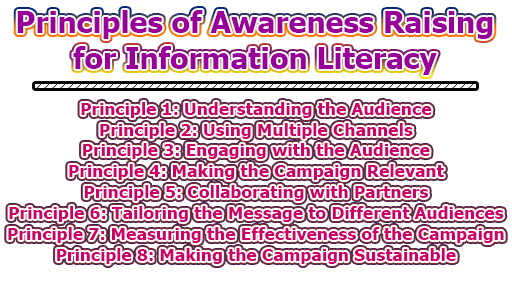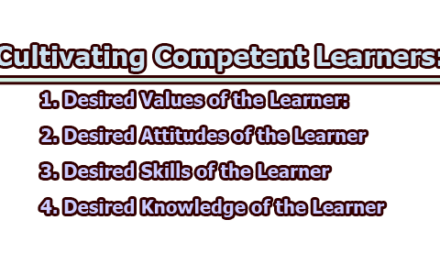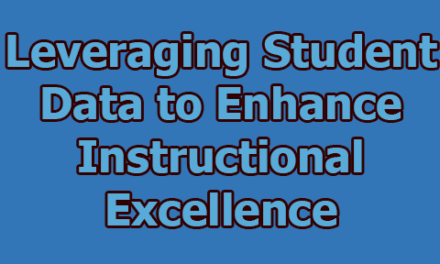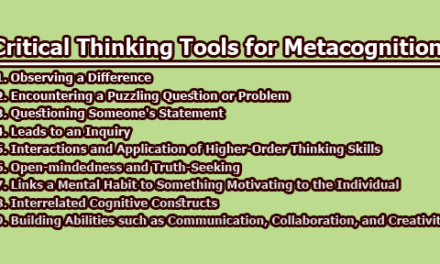Principles of Awareness-raising for Information Literacy:
Information literacy is an essential skill for people in today’s digital age. It involves the ability to identify, locate, evaluate, and use information effectively and ethically. However, not everyone possesses these skills, which can lead to misinformation, confusion, and even harm. Therefore, it is crucial to raise awareness about information literacy and its importance. This article will discuss the principles of awareness-raising for information literacy and provide examples of how they can be applied in various settings.
Principle 1: Understanding the Audience: The first principle of awareness-raising for information literacy is to understand the audience. This involves knowing their background, knowledge level, and interests. Understanding the audience helps in tailoring the awareness-raising campaign to their needs and interests. For instance, if the audience is mostly young people, the campaign can use social media platforms like Instagram, TikTok, or Snapchat to reach them.
In contrast, if the audience is predominantly older adults, the campaign can use traditional media such as newspapers, radio, and television. The campaign’s language and message should also be tailored to the audience’s knowledge level. For example, a campaign targeted at university students may use more technical language than one targeted at the general public.
Example: Understanding the audience for a university information literacy campaign
A university library wants to raise awareness about information literacy among students. To understand the audience, the library conducts a survey to gather data on the student’s knowledge and interest in the subject. The survey results show that most students are unfamiliar with the term ‘information literacy’ and its importance. Therefore, the library decides to use more accessible language and focus on practical examples of how information literacy can help students in their studies.
Principle 2: Using Multiple Channels: The second principle of awareness-raising for information literacy is to use multiple channels. Different people consume information in different ways, and using multiple channels increases the chances of reaching a broader audience. Channels can include social media platforms, websites, posters, flyers, and traditional media. The key is to use channels that the audience is most likely to use.
Example: Using multiple channels for an information literacy campaign in a community library
A community library wants to raise awareness about information literacy among its users. The library uses multiple channels to reach its audience, including posters in the library, flyers distributed in local shops and cafes, social media posts on Facebook and Twitter, and articles in the local newspaper. The library also hosts an information literacy workshop, which is advertised through all these channels. By using multiple channels, the library reaches a broader audience, including those who may not regularly visit the library.
Principle 3: Engaging with the Audience: The third principle of awareness-raising for information literacy is to engage with the audience. Engagement involves encouraging the audience to participate actively in the campaign. It can include activities such as workshops, contests, quizzes, and surveys. Engagement helps to build a connection with the audience and increases the chances of the campaign’s success.
Example: Engaging with the audience for an information literacy campaign in a school
A high school wants to raise awareness about information literacy among its students. The school creates a quiz on information literacy and distributes it to students through their online learning platform. The quiz has questions on identifying credible sources, evaluating information, and citing sources. The students who score the highest on the quiz are entered into a prize draw for a book voucher. The quiz and prize draw generate a lot of interest among the students, and the school sees an increase in the number of students using the library and asking for research help.
Principle 4: Making the Campaign Relevant: The fourth principle of awareness-raising for information literacy is to make the campaign relevant to the audience. The campaign should demonstrate how information literacy can help the audience in their daily lives, studies, or work. Making the campaign relevant to the audience increases their interest and engagement in the campaign.
Example: Making an information literacy campaign relevant to a professional organization
A professional organization wants to raise awareness about information literacy among its members. The organization creates a series of webinars that demonstrate how information literacy can help members in their professional work. The webinars cover topics such as how to find credible sources of information, how to evaluate information, and how to avoid plagiarism. The webinars feature speakers who are experts in the members’ fields, making the content relevant and applicable to their work. The organization sees an increase in the number of members attending the webinars and requesting further information on information literacy.
Principle 5: Collaborating with Partners: The fifth principle of awareness-raising for information literacy is to collaborate with partners. Collaborating with partners increases the reach and impact of the campaign. Partners can include other organizations, educational institutions, and community groups. Collaborating with partners also allows for the sharing of resources and expertise, making the campaign more effective.
Example: Collaborating with partners for an information literacy campaign in a community
A community group wants to raise awareness about information literacy in their town. The group partners with the local library, school, and university to create a campaign that targets different age groups and interests. The library hosts workshops for adults, the school creates a quiz for students, and the university offers free access to academic databases for the community. The group also partners with local businesses to distribute flyers and posters promoting the campaign. The campaign is a success, with a significant increase in the number of people using the library and attending information literacy workshops.
Principle 6: Tailoring the Message to Different Audiences: One message may not resonate with every audience. Therefore, it is crucial to tailor the message to different audiences, so it is relevant and impactful to them. To do this, it is essential to understand the unique characteristics of the audience, including their age, interests, education, and cultural background. Tailoring the message to different audiences can improve their understanding of the importance of information literacy and increase their engagement with the campaign.
Example: Tailoring the message to different audiences in a university
A university wants to raise awareness about information literacy among its students, faculty, and staff. To tailor the message to each audience, the university creates a series of workshops, online tutorials, and posters that address the specific needs and interests of each group. For example, the workshops for students focus on how to find and evaluate sources for research papers, while the workshops for faculty emphasize the importance of teaching information literacy to students. The posters feature real-life examples that are relevant to each audience, such as how to avoid plagiarism in student work or how to find funding opportunities for faculty research.
Principle 7: Measuring the Effectiveness of the Campaign: Measuring the effectiveness of the campaign is critical to understand how well the campaign is working and to identify areas for improvement. To measure the effectiveness of the campaign, it is essential to set measurable goals, such as the number of people reached, the number of people who attend events, or the number of people who take action after learning about information literacy. It is also essential to collect feedback from the audience and evaluate the impact of the campaign over time.
Example: Measuring the effectiveness of an information literacy campaign in a community
A community group wants to raise awareness about information literacy in their town. To measure the effectiveness of the campaign, the group sets goals, such as the number of people attending events and the number of people who take action after learning about information literacy. The group collects feedback from the audience through surveys and social media, and they use this feedback to improve the campaign. Over time, the group evaluates the impact of the campaign by tracking the number of people who attend information literacy events, use the library, and share information literacy resources with others.
Principle 8: Making the Campaign Sustainable: Making the campaign sustainable means creating a plan for the campaign to continue in the future. To make the campaign sustainable, it is essential to identify funding sources, resources, and partners who can support the campaign. It is also essential to create a plan for the campaign to continue after the initial awareness-raising period is over.
Example: Making an information literacy campaign sustainable in a school
A school wants to raise awareness about information literacy among its students. To make the campaign sustainable, the school identifies funding sources, such as grants, to support the campaign. The school also partners with the local library to provide ongoing resources and support for students. The school creates a plan for the campaign to continue by integrating information literacy into the curriculum and offering ongoing workshops and resources for students. By making the campaign sustainable, the school ensures that students have the skills they need to succeed in school and beyond.
In conclusion, these principles, along with the principles mentioned earlier, provide a comprehensive framework for raising awareness about information literacy. By applying these principles, organizations, institutions, and communities can create effective awareness-raising campaigns that help people develop the necessary skills to identify, locate, evaluate, and use information effectively and ethically.
References:
- American Library Association. (2017). Framework for information literacy for higher education.
- Association of College and Research Libraries. (2015). Information literacy competency standards for higher education.
- Bruce, C. (1997). The seven faces of information literacy. Adelaide, Australia: Auslib Press.
- Bruce, C. (2008). Informed learning. Chicago: American Library Association.
- Grassian, E. S., & Kaplowitz, J. R. (2009). Information literacy instruction: Theory and practice (2nd ed.). New York: Neal-Schuman Publishers.
- Horton, F. W., & Hall, H. M. (2015). A review of information literacy instruction models. Journal of Academic Librarianship, 41(2), 246-258.
- Ito, M., Gutiérrez, K., Livingstone, S., Penuel, B., Rhodes, J., Salen, K., Watkins, S. C. (2013). Connected learning: An agenda for research and design. Irvine, CA: Digital Media and Learning Research Hub.
- Lanning, L. A., & Martin, J. R. (2008). Information literacy and information skills instruction: Applying research to practice in the 21st-century school library (3rd ed.). New York: Neal-Schuman Publishers.
- Webber, S., & Johnston, B. (2000). Conceptions of information literacy: New perspectives and implications. Journal of Information Science, 26(6), 381-397.

Library Lecturer at Nurul Amin Degree College










